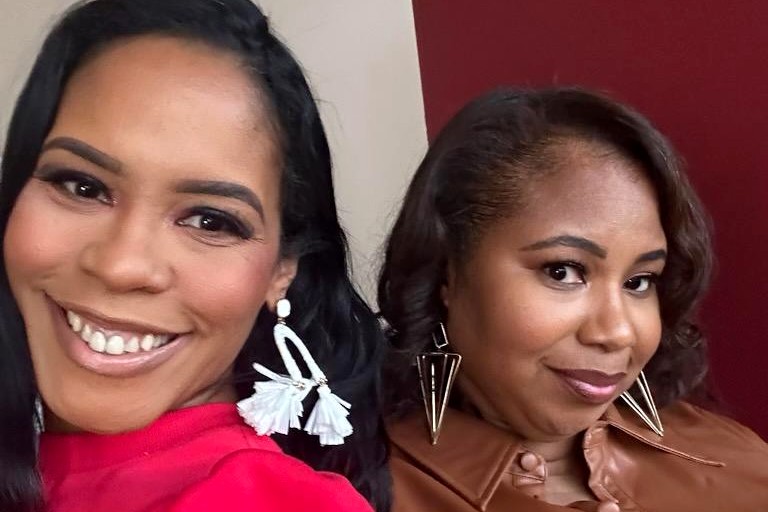Stitch by stitch, quilt making has played an integral role in African American history. But the storytelling embedded in the quilts themselves is more than mere tradition.
In the Afrofuturism & Quilts: Materializing Black Futures & Black Womxn’s Quilt Legacies Exhibition now on display through Friday, July 19, at the MSU Union Art Gallery, local and national quilt artists and quilt scholars explore embodied and theoretical connections between Afrofuturism and quilt making. Each piece in the exhibition highlights aspects of the quiltmaker’s identity and experiences as well as their beliefs, hopes, and imaginings of a liberated Afrofuture.

Dr. Liv Furman curated the exhibition. Furman is currently a Post-Doctoral Research Associate in the Department of African American and African Studies (AAAS) at Michigan State University and the Assistant Project Director of the Black Diaspora Quilt History Project (BDQHP). Within their role in the BDQHP, they document and explore the myriad histories of Black quilt makers throughout the diaspora.
Furman, a non-binary womanist, artist, educator, and researcher, has made more than 20 quilts, one of which is part of the Afrofuturism & Quilts Exhibition. The other artists whose work appears in the exhibition include Diana Baird N’Diaye, Rebecca Christian-Lipker, Janda Lipker, Carole Lyles Shaw, April Shipp, Elka Stevens, and Chiquita Whitfield. An opening reception for the exhibition is scheduled for Friday, April 19, from 5 to 7 p.m. The reception will include artist talks from five local artists included in the exhibit.
“I’m honored to be part of this exhibition that celebrates the power and beauty of Black creativity,” Furman said. “Through quilting, we materialize Black futures and offer glimpses into a world of boundless possibilities and collective flourishing.”
Lasting Legacies of Quilt Making
Growing up in Louisville, Kentucky, Furman learned quilt making from their grandmother, Mary Frances Furman.
“She would teach us things like gardening, crafting, crocheting, and quilting. It was a very care-centered space,” Furman said. “As I got older, I started making quilts for people as gifts. I didn’t always have a lot of money, but I did have these skills that were taught to me by my grandmother. I began including quilting as part of my scholarship when I was at Notre Dame for undergrad. I made a family tree quilt for a class project that was all about legacy and genealogy in the Black community, and that was the first time I made quilts as academic work.”

Furman has a B.A. in Africana Studies and a master’s in Elementary Education, both from the University of Notre Dame. They came to Michigan State University in 2017 for the College of Education’s doctoral program in Curriculum Instruction and earned their Ph.D. in 2022.
Now as a Post-Doctoral Research Associate in the Department of African American and African Studies, Furman brings a love of quilt making into their classes and curriculum design. During the Fall 2023 semester, for example, the students in Furman’s Black Ecologies and Environmental Justice class helped design and co-construct a quilt.
“It has all the students’ names on it as well as affirmations that they wrote and used to inspire themselves and ground themselves in their own Black ecologies. They had a good time designing the quilt and had never done something like that before,” Furman said. “That quilt is now hanging in our department. I plan to continue to use quilting as a teaching resource, just like you would a book or an article.”
“I plan to continue to use quilting as a teaching resource, just like you would a book or an article.”
Dr. Liv Furman
Furman explains that quilting is “a beautiful thing” to bring into school spaces and is focused on the healing powers of quilt making for both adults and children as an inexpensive and sustainable practice that’s connected with past generations.
“Typically, as you quilt, you talk,” Furman said. “Those conversations allow you to express who you are. They allow for you to have relationships of care with whoever you’re working with. For students who have gone through the social isolation of the pandemic, quilting can be a space where they can get those human interactions with adults and other students who care about them. They can talk and express their feelings while doing a practice that is meditative and even relaxing.”

Adults, too, can learn much from the lasting legacies of Black quilters.
“Black folks, during times of enslavement, sometimes didn’t have a choice on what they could use,” Furman said. “Sometimes they had to use old feed sacks and other things that were thrown away, or things that were free or cheap, or use their own income to purchase their own materials. Our ancestors have already done that. We can learn lessons from their quilting praxis and think about how we can continue to grow from that.”
Quilting Viewed Through an Afrofuturism Lens
The Black Diaspora Quilt History Project, which is hosting the Afrofuturism & Quilts Exhibition, aims to preserve and make accessible for teaching and research the work and stories of Black quilters. Dr. Marsha MacDowell, Director of The Quilt Index and Professor in the Department of Art, Art History, and Design at MSU, organized and developed the BDQHP to include collaborations with multiple quilt scholars, curators, and historians. One BDQHP collaborator is Dr. Julian Chambliss, Professor of English at MSU and the Val Berryman Curator of History at the MSU Museum. MacDowell suggested that Furman’s focus on quilting would make an interesting pairing with Chambliss’ research on Afrofuturism.
In order to make known the theoretical groundwork for the Afrofuturism & Quilts Exhibition, Chambliss and Furman co-planned and moderated the Afrofuturism & Quilts Virtual Panel on Oct. 5, 2023. This panel explored theoretical and experiential context regarding themes of Afrofuturism, quilt making, and the legacies of Black art/craft. The panelists for this event included: Ytasha Womack, John Jennings, Elka Stevens, and Deimosa Webber-Bey.

There are many, fluid, definitions of Afrofuturism. Furman notes that their personal definition of Afrofuturism “encompasses multifaceted cultural aesthetics, style methods, genres, lenses and/or lifestyles, which combine themes of science fiction, fantasy, technology, liberation, and the future with Black and/or African diasporic history and culture. Afrofuturism is a way of reclaiming and reimagining Black futures and the Black imaginary that is deeply rooted in and inseparable from the identities, experiences, histories, and embodied knowledge of Black people, our elders, and ancestors. Afrofuturism is an outgrowth of Black life and Black folx’s being.”
While modern technology and science fiction may seem quite disparate from traditional quilt making to some, Furman says they are interestingly similar in terms of how they present themes of Afrofuturism.
“Many quilt makers would make narrative quilts or story quilts that are meaningful to them, representing the actual dreams, stories, thoughts, and conversations that these folks had as they were quilting. In this way, these quilt makers were literally able to materialize their own Black futures.”
Dr. Liv Furman
“The heart of Afrofuturism is basically imagining different possibilities that exist for Black people, either now or in a future sense,” Furman said. “During times of enslavement and even now, Black women would make quilts for money or trade. It was a way to sustain themselves and materialize a better future for their families. Also, many quilt makers would make narrative quilts or story quilts that are meaningful to them, representing the actual dreams, stories, thoughts, and conversations that these folks had as they were quilting. In this way, these quilt makers were literally able to materialize their own Black futures.”
The Black Diaspora Quilt History Project began with a grant from the National Endowment for the Humanities that was written by MacDowell. It is now part of Michigan State University’s Quilt Index, which is an open access, digital repository of thousands of images, stories, and information about quilts and their makers drawn from hundreds of public and private collections from around the world. Originally launched in 2003, the Quilt Index is a digital humanities research and education project of Matrix: Center for Digital Humanities & Social Sciences at Michigan State University.

As the Assistant Project Director of the BDQHP, Furman works with other Quilt Index staff to preserve primary and secondary sources on African American, African, and African Diasporic quilt history drawn from geographically dispersed public and private collections. These resources are available on the BDQHP Collections Page on the Quilt Index website.
For more information about the Black Diaspora Quilt History Project and the Afrofuturism & Quilts Exhibition, check out the resources below:
Article:
- The Black Diaspora Quilt History Project: A Resource for Inclusive Preservation, Research, and Teaching” by Marsha MacDowell and Olivia Furman, Journal of Folklore and Education, 2023.


